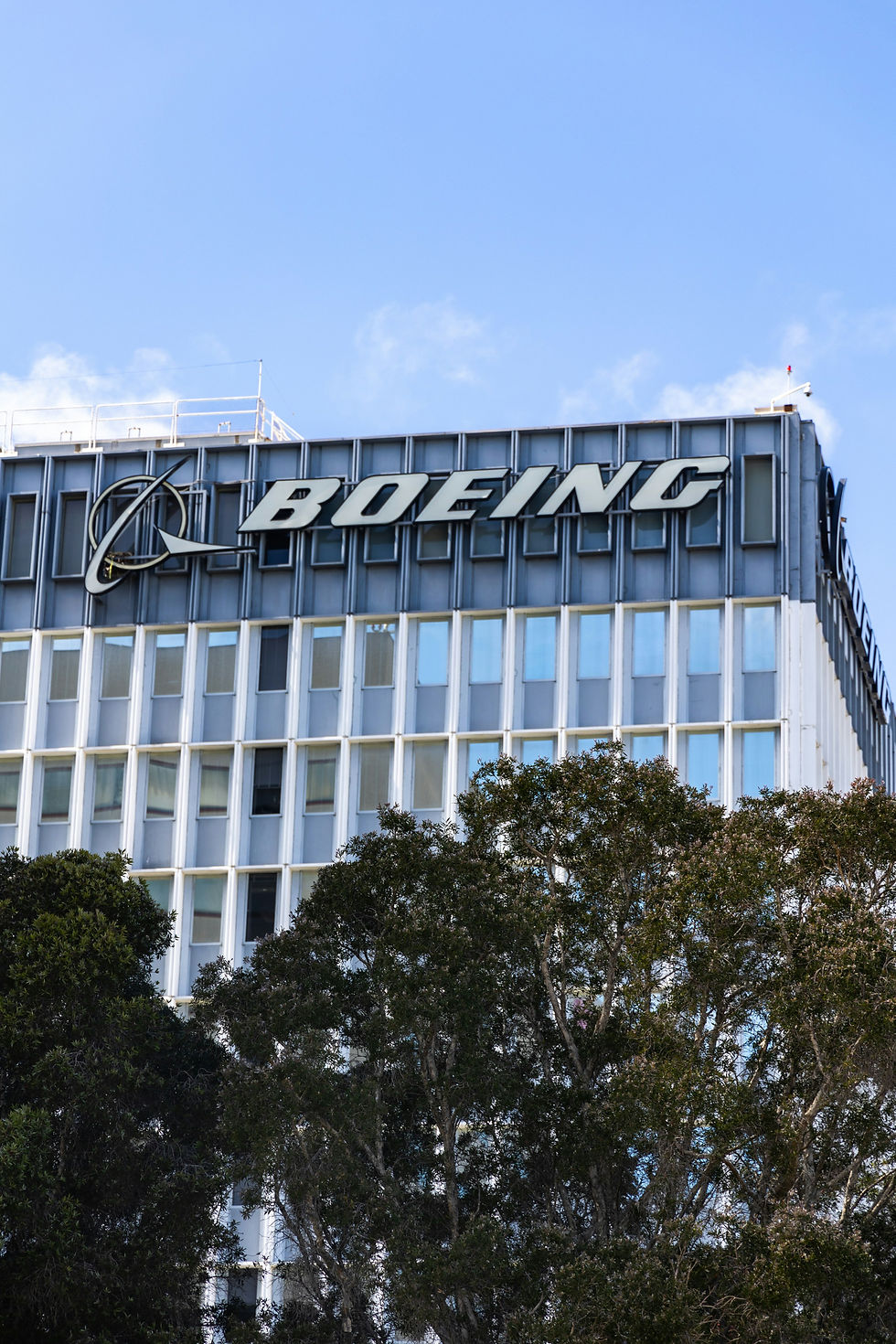Boeing: Navigating Challenges, Securing Growth—A Resilient Investment Opportunity in Aerospace
- Prospia Investment Analysis Team

- Nov 1, 2024
- 5 min read
Updated: Nov 4, 2024

Boeing as a Potential Investment Opportunity
Boeing stands as one of the most important players in the aerospace industry, with a heavily established brand and legacy that commands trust around the world. Despite recent operational and financial challenges affecting its stock price, Boeing’s intrinsic value and reputation position it as a viable investment. While relatively short-term setbacks have impacted shareholder sentiment, these issues are likely irrelevant in terms of Boeing’s long-term prospects as a leader in aviation. For a company of Boeing’s stature, resilience and success are inevitable, making it a viable investment opportunity amidst doubt in the markets.
Boeing’s Brand Strength and Market Perception
Since its founding in 1916, Boeing has had a long-standing reputation for safety and reliability. The company has bolstered its reputation through engineering marvels like the Boeing 747. Although Boeing has recently had many notable incidents, they have focused on being transparent and open with its shareholders. For example, production issues with the 787 Dreamliner, delays in the 777X program, software glitches affecting 737 MAX deliveries, supply chain disruptions, and quality control concerns have been openly handled by the company as they have been in direct communication with the National Transportation Safety Board in order to improve and learn from their mistakes. Another key factor is brand loyalty. Boeing’s brand strength is comparable to companies such as Coca-Cola and Apple. This loyalty and strength has been based on customer trust, market stability, innovation, and collaboration. Ultimately, Boeing’s long-standing reputation allows it to build strong brand loyalty, further bolstering its position in the aerospace industry and ensuring its continued relevance and resilience in the market.
Boeing has a huge brand name that involves years of experience in the market, which competitors like COMAC and others lack. Boeing also has government contracts on military vehicles, with the V-22 Osprey and Air Force One being two of the most well-known. Three years ago, Chinese airframer COMAC landed on the US government's blacklist of “communist Chinese military companies,” where it could face sanctions and other boycotts. This shone a negative light on COMAC’s reliability. In combination with its long standing history of serving US citizens, Boeing is set far ahead of their competitors.
Operational Challenges and Financial Setbacks
Boeing has faced several operational and financial setbacks that have significantly impacted its stock price, including manufacturing delays and supply chain disruptions, particularly in the production of its 737 Max and 787 Dreamliner aircraft. Additionally, protests from employees and labor unions over working conditions have strained internal dynamics, contributing to production slowdowns. Financially, Boeing has struggled with rising costs and has faced accusations of fraud and misleading investors, including a high-profile lawsuit related to the 737 Max crashes. These issues have collectively damaged investor confidence, further pressuring Boeing’s stock performance as it navigates these challenges.
Boeing’s financial strategy has recently centered on a significant $10 billion credit agreement aimed at facilitating recovery in the wake of industry challenges. This move not only addresses immediate liquidity needs but also signals confidence in long-term growth prospects. The funds are expected to support investment in new technologies and production capabilities, enhancing Boeing’s competitive position.
Sustained Market Demand for Aircraft
Boeing’s $400 billion order backlog highlights sustained demand and supports financial stability amid challenges. Orders for key models like the 737 MAX and 787 Dreamliner show strong client confidence, positioning Boeing for recovery as it addresses production issues. This pipeline of demand reinforces Boeing’s market position, providing investors a solid foundation for long-term growth.
The global demand for air travel has received significant growth over recent years, particularly in emerging markets such as China, India, and Southeast Asia. Rising incomes, urbanization, economic growth, and an expanding middle class are driving increased travel in regions like China, India, and Southeast Asia, contributing to a broader shift in air travel trends. These areas are experiencing significant growth in demand, caused by economic expansion and government investments. China is on track to become the world’s largest aviation market by the mid-2030s, with massive infrastructure projects underway. India, supported by initiatives like UDAN, is expected to become the third-largest aviation market within a decade as air travel increasingly replaces other modes of domestic transport. In Southeast Asia, countries like Indonesia, Vietnam, and Thailand are seeing strong growth, with low-cost carriers making flights more accessible. These regions will shape the future of global air travel, where infrastructure and sustainable technologies will be essential.
Valuation and Investment Prospects
Since its 52-week high, Boeing has dropped 40%. This fall in share price is due to ongoing production delays, regulatory challenges, weakened defense contract demand, broader economic concerns, and disruptions from recent labor strikes affecting suppliers. In 2019, the stock price was a staggering $430. This peak came before the 737-MAX crises and the COVID-19 Pandemic, Boeing has dropped nearly 65% since then. Through Boeing’s fall over the past 5 years, their competitors, Lockheed Martin, General Dynamics, and Northrop Grumman have grown 85%, 75%, and 94%, respectively. Despite this divergence, Boeing still has a 15-20% market share in the Defense and Aerospace Industry domestically, in addition to their 45%-50% stake in Commercial Aviation as they are in a duopoly with Airbus. Additionally, Boeing's extensive order backlog signals strong demand, suggesting a potential path to recovery as global air travel rebounds. While challenges remain, addressing these operational hurdles could enable Boeing to leverage its dominant position in aerospace, driving a potential comeback toward pre-pandemic performance levels.
Key Risk Factors Impacting Boeing
Boeing has a number of regulation issues like the recertification of the 737 MAX which was heavily scrutinized by the FAA and other aviation authorities. The aircraft was allowed for flight but Boeing’s continuous oversight and compliance has been a focus since 2021. Boeing has also had production quality issues, specifically with the 787 Dreamliner having damaged parts, unsecured fuel lines, and multiple other issues. Additionally,in 2021, the European Union proposed stricter emissions standards which may affect Boeing’s future production practices. Boeing continues to be under investigation for various issues under the FAA and other global aviation authorities about lying to regulators about the safety of aircrafts and cutting corners.
Boeing's Defense and Space division has struggled with substantial challenges over recent years. Despite its strong foothold in defense, Boeing faces ongoing challenges including production delays and quality control concerns in key programs like the KC-46 Pegasus and P-8 Poseidon. Additionally, the company has struggled with significant cost overruns and navigating a competitive landscape. Despite this, Boeing is committed to innovation and improving efficiency, which is vital for securing future government contracts. On the other hand, marred by years of glitches, Boeing has also faced over $1.6 billion in cost overruns and delays in its space sector. Boeing’s Starliner project has faced many setbacks, while their rival, Elon Musk’s SpaceX, has made 43 visits to the International Space Station since 2019. As a result, Boeing is considering selling this project and stepping away from the space sector after over 60 years in the industry. However, NASA and Boeing are actively working to solve these issues to get Starliner up and running once again, which, if successful, could diminish some concerns associated with the company’s future in the space sector.
Boeing’s Path to Recovery and Future Outlook
In conclusion, Boeing’s promising potential for recovery is characterized by two factors: its substantial market share/strong brand image and how harshly the market has reacted to the company's setbacks, ignoring major potential in the company’s extensive order backlogs. Boeing’s major losses, such as the pandemic-incited 737 MAX crisis, allegations of fraud in overstated production goals, federal investigation into regulatory non-compliance, and quality control issues across multiple aircraft models were largely managerial issues that are being priced in too harshly, ignoring the fact that Boeing maintains a notable global presence in the aerospace industry. Approximately 50% of the machine supply in the commercial aircraft market is due to Boeing, the other 50% belonging to Airbus with Boeing also controlling about 20% of the Defense and Aerospace Industry. These statistics emphasize the company’s strong presence, highlighting that the managerials issues of the past can be overcome.




Comments